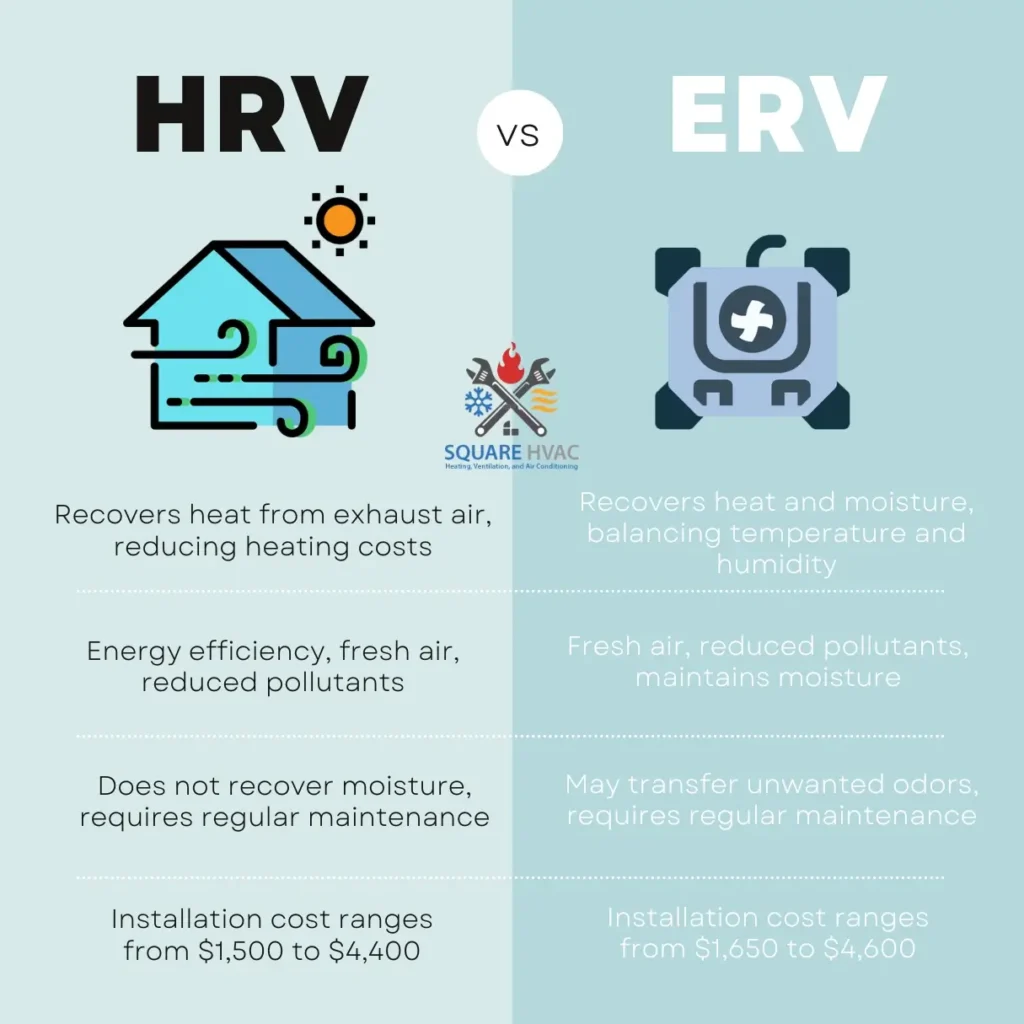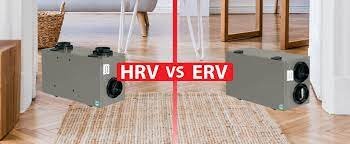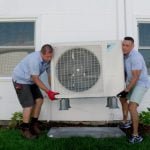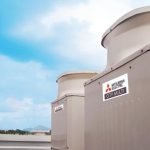HRV vs ERV in Cold Climate: Living in a cold climate means you know the importance of a comfortable and healthy indoor environment. You also know how challenging it can be to achieve that, especially when dealing with low temperatures, high humidity, and poor air quality. That’s why you need a ventilation system that can provide fresh air, remove pollutants, and recover energy from the exhaust air. But which ventilation system is best for your home?
Both systems are similar in that they exchange stale indoor air with fresh outdoor air and transfer heat between the two air streams. However, they differ in how they handle moisture and humidity. In this blog post, we will explain the difference between HRV and ERV and help you choose the right one for your cold-climate home.
What is HRV?
HRV stands for heat recovery ventilator. HRV is a ventilation system that recovers heat from the exhaust air and transfers it to the incoming air. HRV has a core that consists of sealed dividing walls that separate the two air streams. The walls allow heat to pass through, but not moisture. This means that HRV can reduce your home’s heating load but not its humidity level. HRV is best suited for homes with high humidity problems, such as condensation, mold, and mildew. HRV can help lower indoor humidity by expelling the moist air and bringing in dry air.
What is ERV?
ERV stands for energy recovery ventilator. An ERV is an efficient ventilation system that helps to regulate the temperature and humidity level of your home. It works by recovering heat and moisture from the exhaust air and transferring them to the incoming air. The system includes a core made of desiccant material that absorbs and releases moisture, allowing it to balance your home’s humidity levels and temperature. You can view our in-depth guide on Components Of HVAC Systems.
ERV is beneficial for homes with low humidity levels, as it can help alleviate issues such as dryness, static electricity, and cracked wood. By retaining moist air and bringing in humid air, an ERV can help increase the indoor humidity level of your home.
Explore HRV vs ERV in Cold Climate Efficiently
| Feature | HRV | ERV |
| Overview | Heat Recovery Ventilator | Energy Recovery Ventilator |
| Function | Recovers heat from exhaust air, reducing heating costs | Recovers heat and moisture, balancing temperature and humidity |
| Advantages | Energy efficiency, fresh air, reduced pollutants | Fresh air, reduced pollutants, maintains moisture |
| Disadvantages | Does not recover moisture, requires regular maintenance | May transfer unwanted odors, requires regular maintenance |
| Special Considerations | Built-in defrost systems for colder climates | Better for hot and humid climates, may transfer odors |
| Cost | Installation cost ranges from $1,500 to $4,400 | Installation cost ranges from $1,650 to $4,600 |
| Considerations | Consider humidity levels and maintenance needs | Consider odors, humidity levels, and maintenance needs |
HRV vs ERV in Cold Climate: Pros and Cons
Here are some of the advantages and disadvantages of each system:

What Are The Advantages Of HRV
Energy efficiency
HRV, or Heat Recovery Ventilation, can help you save energy and money by effectively recovering up to 80% of the heat from the exhaust air and transferring it to the incoming air. This results in the reduction of the energy required to heat your home. Moreover, HRV can also enhance the efficiency of your heating system by reducing the temperature difference between the indoor and outdoor air.
Fresh Air in Your Home
They provide fresh air and reduce pollutants and allergens in the home. This improves the indoor air quality and the health and comfort of the occupants. Pollutants and allergens can come from various sources, such as cooking, smoking, pets, dust, mold, and chemicals.
Recover Heat from Outgoing Air
They recover heat from the outgoing air and transfer it to the incoming air, saving energy and reducing heating costs. This is because the outgoing air is usually warmer than the incoming air in winter, and the heat exchanger in the HRV system can capture up to 85% of the heat and use it to preheat the incoming air. This reduces the load on the heating system and lowers the energy bills.
You Can Read our Guide on Delta T In HVAC System: What It Is And Why It Matters 2023
Reduced Carbon Footprint
They reduce the carbon footprint of the home by minimizing carbon dioxide emissions. This is because they reduce the amount of fossil fuels needed to heat the house and, thus, the amount of greenhouse gases released into the atmosphere. Carbon dioxide is one of the main contributors to global warming and climate change.
Built-in defrost systems
They have built-in defrost systems that make them ideal for colder climates. This is because they prevent the heat exchanger from freezing and malfunctioning when the outdoor temperature drops below zero. The defrost system can either use an electric heater or divert warm air from the home to melt the ice on the heat exchanger.
What Are The Disadvantages Of HRV?
do not recover moisture from the outgoing air
They do not recover moisture from the outgoing air, which can make the indoor air too dry in winter. This can cause discomfort, irritation, and health problems for the occupants, such as dry skin, eyes, nose, and throat, as well as increased susceptibility to infections and respiratory diseases. Additional humidifiers may be needed to maintain a healthy humidity level, which can increase energy consumption and cost.
regular maintenance and cleaning
They require regular maintenance and cleaning of the filters and ducts. This is because they can accumulate dust, dirt, and debris over time, reducing their efficiency and performance and creating a breeding ground for bacteria and mold. The filters and ducts should be inspected and cleaned at least once a year, and the filters should be replaced every three to six months.
noisy and expensive to install
They can be noisy and expensive to install. This is because they have fans and motors that generate sound, and they need ductwork and vents that can be difficult and costly to install, especially in existing homes. The noise level can vary depending on the size, speed, and quality of the fans and the design and layout of the ductwork. Some HRV systems may have silencers or sound dampeners to reduce the noise.
- High Energy efficiency
- Fresh Air in Your Home
- Recover Heat from Outgoing Air
- Reduced Carbon Footprint
- Built-in defrost systems /li>
- Don’t recover moisture from the outgoing air
- Regular Maintenance and Cleaning
- Noisy and Expensive to Install
What Are The Advantages Of ERV systems:
Fresh air and reduce pollutants
They provide fresh air and reduce pollutants and allergens in the home. This improves the indoor air quality and the health and comfort of the occupants. Pollutants and allergens can come from various sources, such as cooking, smoking, pets, dust, mold, and chemicals.
Maintain Moisture
ERV systems recover heat and moisture from outgoing air, transferring them to incoming air for energy savings and optimal home humidity. In winter, outgoing air, typically warmer and more humid, undergoes exchange in the ERV system, capturing up to 80% heat and 60% moisture. This process preconditions incoming air, reducing the load on heating and humidifying systems and cutting energy costs.
Reduce the carbon footprint.
They reduce the carbon footprint of the home by minimizing carbon dioxide emissions. This is because they reduce the amount of fossil fuels needed to heat and humidify the house and, thus, the amount of greenhouse gases released into the atmosphere. Carbon dioxide is one of the main contributors to global warming and climate change.
You Can Read our Guide on Heat Pump vs. propane Furnace.
better for hot and humid climates
In hot and humid climates, ERV systems excel by preventing excess moisture and lowering the need for air conditioning. Incoming air, typically warmer and more humid in summer, undergoes an exchange capturing 70% of heat and 50% moisture. This energy-efficient process cools and dehumidifies incoming air, reducing the strain on cooling systems and cutting energy bills.
What Are The Disadvantages Of ERV systems:
Transfer unwanted odors and contaminants
They can transfer unwanted odors and contaminants from the outgoing air to the incoming air. This is because the heat and moisture exchanger in the ERV system is not a perfect barrier, and some of the air molecules can cross over from one stream to another. This can result in unpleasant smells, such as cooking, smoking, pet odors, or harmful substances, such as volatile organic compounds (VOCs), radon, or carbon monoxide, entering the home.
Require regular maintenance
They require regular maintenance and cleaning of the filters and ducts. This is because they can accumulate dust, dirt, and debris over time, reducing their efficiency and performance and creating a breeding ground for bacteria and mold. The filters and ducts should be inspected and cleaned at least once a year, and the filters should be replaced every three to six months.
expensive to install
They can be noisy and expensive to install. This is because they have fans and motors that generate sound, and they need ductwork and vents that can be difficult and costly to install, especially in existing homes. The noise level can vary depending on the size, speed, and quality of the fans and the design and layout of the ductwork. Some ERV systems may have silencers or sound dampeners to reduce the noise.
- Fresh air and reduce pollutants
- Maintain Moisture
- Reduce the carbon footprint
- Better for Hot and Humid Climates
- Transfer unwanted odors and contaminants
- Regular Maintenance and Cleaning
- Expensive to Install
HRV vs ERV: Cost
The cost of installing an HRV or ERV system depends on several factors, such as the size, type, brand, and efficiency of the unit, the complexity of the installation, and the location and condition of your home. However, some sources say ERVs typically cost $150 to $200 more than HRVs before installation. The units often cost $1,000 to $1,900. The installation cost can vary from $500 to $1,700, depending on the contractor and the scope of the work. Therefore, the total cost of an HRV system can range from $1,500 to $4,400, while the total price of an ERV system can range from $1,650 to $4,600.
Consider long-term costs and benefits, such as energy savings, maintenance, and occupant comfort. Choose a system that provides the most value in your climate, home, and preference.
Conclusion
HRV and ERV are ventilation systems that provide fresh air, remove pollutants, and recover energy. HRV reduces humidity but not temperature, while ERV balances both. Consult a professional contractor to choose the right system for your home based on your climate, house, and preference.





